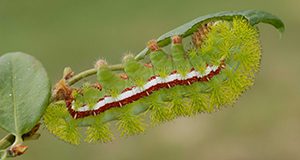Abstract
Wasp and bee stings are familiar to most people, but some might be surprised to learn that several caterpillars can also sting. This painful experience results from coming into contact with, or handling, a stinging caterpillar. Unlike wasps and bees with stingers, these caterpillars have urticating hairs, which are barbed and easily break off the caterpillar’s body, causing sudden or gradually building pain. Caterpillars urticate these spines upon contact with skin or when they feel threatened. The severity of a sting varies based on the person and number of spines embedded in the skin. Many stinging caterpillars also release a toxin on contact, which may be of health concern. The caterpillars discussed in this document are found throughout the southeastern U.S.
https://edis.ifas.ufl.edu/in014
Unless otherwise specified, articles published in the EDIS journal after January 1, 2024 are licensed under a Creative Commons Attribution-NonCommercial-NoDerivs 4.0 International (CC BY-NC-ND 4.0) license.

